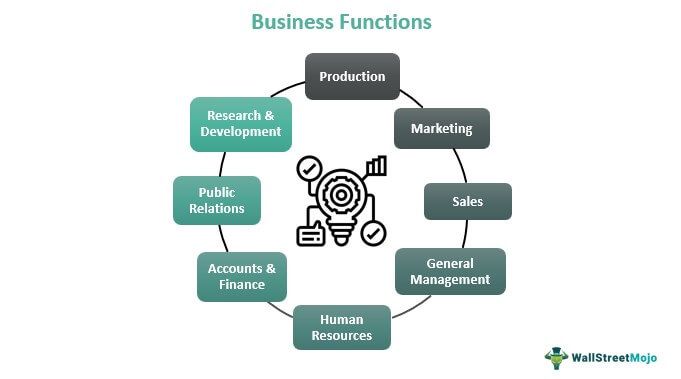Table Of Contents
What Are Business Functions?
Business functions are the activities performed by a business, and the activities demonstrates the purpose of the business. Well-structured business functions ensure a company is successful for its customers, employees, investors, and other stakeholders.

The activities, measures, or processes undertaken by a business are specific to its functions and support the smooth operation of any organization and maximize its success. The term "function" describes the organizational component and the kinds of tasks it carries out.
Key Takeaways
- Business functions are the activities a business performs to achieve its goals and objectives. It produces revenue and supports revenue-generating activities.
- Business function types are divided into two categories: core functions and support functions.
- The former refers to the primary activities involved in managing the business, whereas the latter is involved in secondary activities for the growth and revenue generation of the organization.
- The business process is different from it. Business processes indicate specific tasks performed to attain goals.
Business Function Explained
Business functions explain the procedures the business goes through, engage and design. They are the systems, tasks, and processes that make up a company's daily operations. These can range from finance, sales, and marketing to human resources. The daily business operations are attributed to various functions. They assist in assessing the company's performance and generating new plans for its expansion. Marketing, finance, human resources, and production are a company's primary functions that ensure the success and failures of the business.
Types
Business functions are divided into two broad categories: core functions and support functions. While support functions don't directly provide funds to the company, core functions are all directly fund-yielding. It is intended to assist the fundamental operations. Combined, both functions increase the organization's efficiency and result in positive feedback. Once the functions and their differences are clearly understood, it is easy to identify the process that needs to be optimized to meet the defined goal.
- Core Functions: The enterprise's core business functions constitute its main activity or operations. In other words, the revenue-generating function. However, it may also comprise additional secondary activities if the company views them as core activities. Examples include:
- Production of goods & services
- Finance
- Marketing
2. Support Functions: The support business functions are additional or supporting tasks that it performs to enable or facilitate its production activity, which is one of its core business functions. The outputs of support functions are not directly aimed at the market or other external audiences. A business's various tasks are categorized as business functions under support functions. These responsibilities are divided into sales, administration, production, finance, accounting, and marketing. Examples include:
- Public relations
- Quality control
Examples
Let us look at business function examples to understand the concept better:
- Public Relations: A public relations or communications department manages all facets of public relations, internal branding, corporate communications, client servicing, and crisis management for a business or brand. To represent a business, they prepare press releases, connect with reporters and editors, serve as spokespersons in response to difficulties or concerns, and create speeches or policy proposals for CEOs and top executives.
- Research and Development (R&D): Businesses or organizations engaged in research and development (R&D) drive innovation. To assist businesses in developing new goods, services, or revenue streams that will increase profits, the R&D team conducts market research, industry comparisons, trend detection, product creation, and business experimentation. Firms and departments involved in research and development have extensive experience in analysis and a thorough awareness of the market circumstances in a particular industry or area.
- Sales and Marketing: To generate brand awareness and revenue, sales and marketing teams interact with possible investors, clients, customers, or sponsors to grow their organization. It involves selecting the audience, determining fair prices and promotions, and designing and conducting successful marketing and advertising campaigns.
- Human Resource: Companies and departments in human resources concentrate on tasks related to employees, such as finding top talent, conducting background checks on applicants, hiring, outlining benefits, handling performance management and employee relations, creating corporate policies, and promoting organizational culture. Along with resolving disputes and looking into claims or allegations, HR businesses or departments also ensure that employment rules and regulations are followed.
Importance
The main objective of the business is to generate income while offering its clients services and goods. The business's fundamental activities surrounding the generation of goods and services are its business functions. They are the functions that make it possible for an organization to conduct business and are in charge of ensuring that everything remains organized. These tasks have one straightforward goal: to ensure that the company works efficiently and contributes to the going concern concept.
Business Functions vs Business Process
| Business Function | Business Process |
|---|---|
| Activities performed by an organization and ensuring the functioning of an organization. | Tasks performed to achieve a goal. |
| Example: Research & development and sales & marketing | Example: Payroll processing, procurement process, and client onboarding process |
The business function throws insight into a company's goals, objectives, capabilities, and processes. At the same time, business processes involve initiating and completing the defined tasks. Furthermore, business processes can be divided into more manageable parts, known as phases or stages of work. For instance, receiving the customer's order or purchase order is the first step of an order management process or order processing, which concludes with fulfilling the customer's order and handling the post-sales processes.

